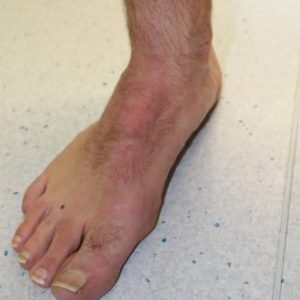Foot and Ankle
The foot and ankle are magnificent pieces of engineering, with many moving parts and the ability to help support our body weight on various terrains. It is no wonder that sometimes these areas can cause us pain and discomfort.

The foot and ankle are magnificent pieces of engineering, with many moving parts and the ability to help support our body weight on various terrains. It is no wonder that sometimes these areas can cause us pain and discomfort.
There are many causes of foot and ankle pain. Some may be due to a specific incident, others part of an ongoing change to your body or other medical conditions.
Below are links to more information about common conditions affecting the foot and ankle. Click on the image that best represents the area you have symptoms for more details.
Often, making some simple adaptations such as weight-loss, different footwear, foot exercises, insoles and lifestyle changes can significantly help with pain.
Appropriate fitting footwear will often help support your recovery. Up to 65% of people wear inappropriate-fitting shoes, contributing to foot pain. Simple changes such as wider-fit shoes or wearing a more structured, supportive shoe can help reduce discomfort and allow recovery.
A bunion, for instance, will need space and soft side materials next to the joint in the toe box. In contrast, heel/arch pain requires a supportive, structured, cushioned shoe with a possible introduction of a heel lift or arch support.
See our footwear page for more information
Foot insoles and orthotics can offer further support or improve the fit of footwear. They vary in profile and material density, so be careful to select the right support for your needs.
Often, movement helps the joints and soft tissues recover, so some exercises may also support a return to function. They can help reduce pain but may also provide better mobility and stability. We need to move our feet for everyday life and being more comfortable with movement is encouraged.
Information from Versus Arthritis: Exercises for the toes, feet and ankles | Versus Arthritis
Versus Arthritis Video: Tailored stretching: Ankle, foot and toe exercises (for arthritis and joint pain)
Exercises for Ankle Mobility and Foot Strength Video: Exercises for Ankle Mobility and Foot Strength (Part 1) – YouTube
Physical activity is good for your overall health, however if your foot pain is not recovering, you might find it helpful to adapt your activities. For example, if running is causing pain and you are struggling with impact, then the introduction of a gym session with weights might be a helpful alternative to stay active. Low-impact exercise might help your foot recover, such as swimming and cycling. Consider adapting your routine; if you’re struggling to walk the distance you usually do to work, try cycling or taking the bus instead.
A balanced, healthy diet is encouraged to support your body’s recovery. Metabolic disorders can affect foot conditions; uncontrolled diabetes can lead to reduced foot function.
An increase in weight or being overweight can put an extra load on the feet, which may also slow your recovery.
See our “Healthy Living” section for more information on healthy weight
Stopping smoking has positive health effects on bone health and tissue recovery. Smoking can affect circulation, which can be particularly challenging for the feet.
See our “Healthy Living” section for more information on local stop smoking services
Allowing our body to recover is important; poor sleep can affect our perception of pain. Emotionally challenging times can heighten pain experiences- plantar fasciopathy has been shown to be a higher intensity in patients experiencing anxiety and depression.
Foot pain can settle on its own, sometimes, it can take a little longer, but this does not mean there is something seriously harmful occurring. If you have the following, you should seek advice from a health professional via your GP practice:
A referral to local musculoskeletal services is required in some instances, and your healthcare professional can advise on appropriate treatment or pathways suitable to you.